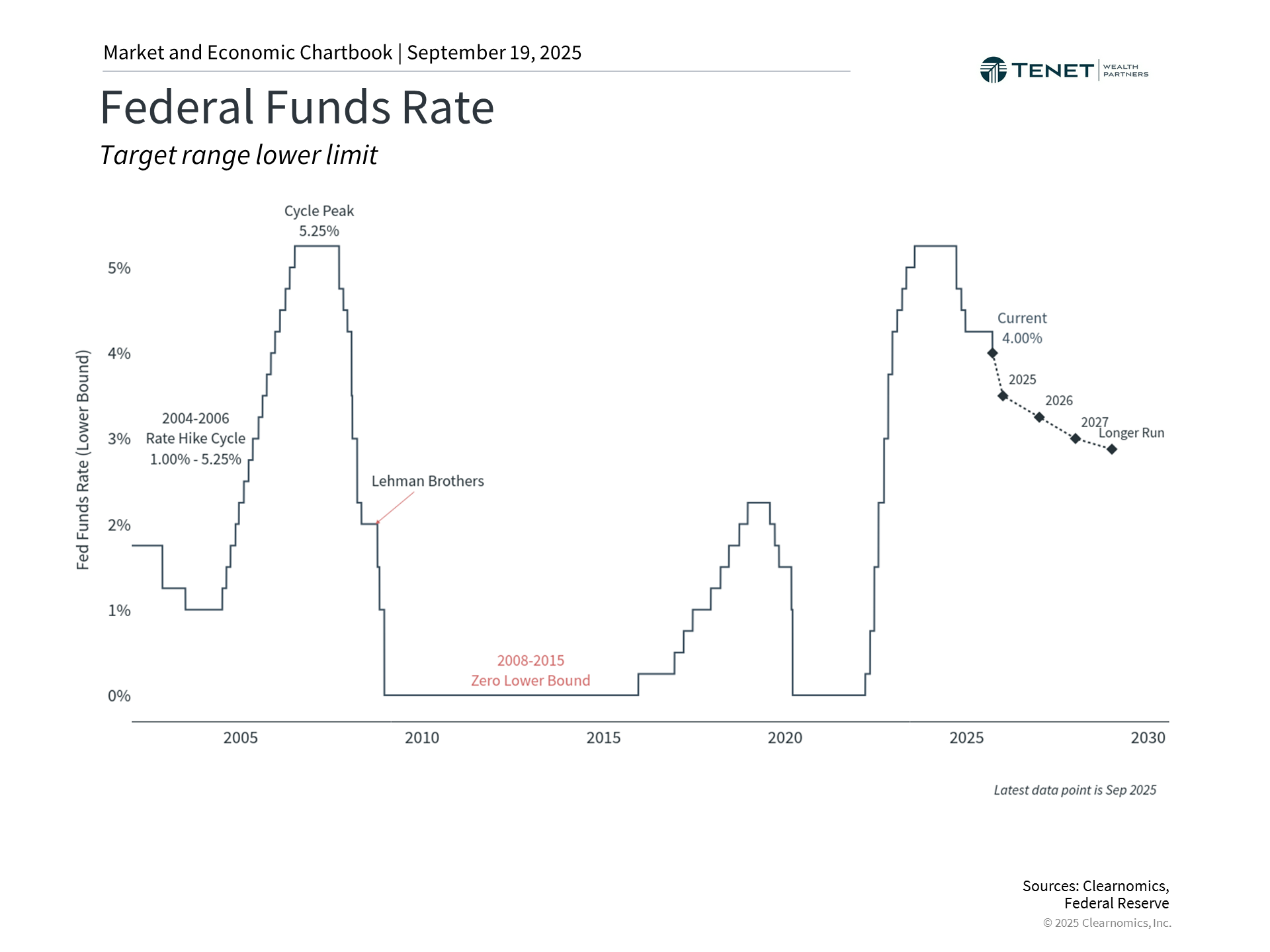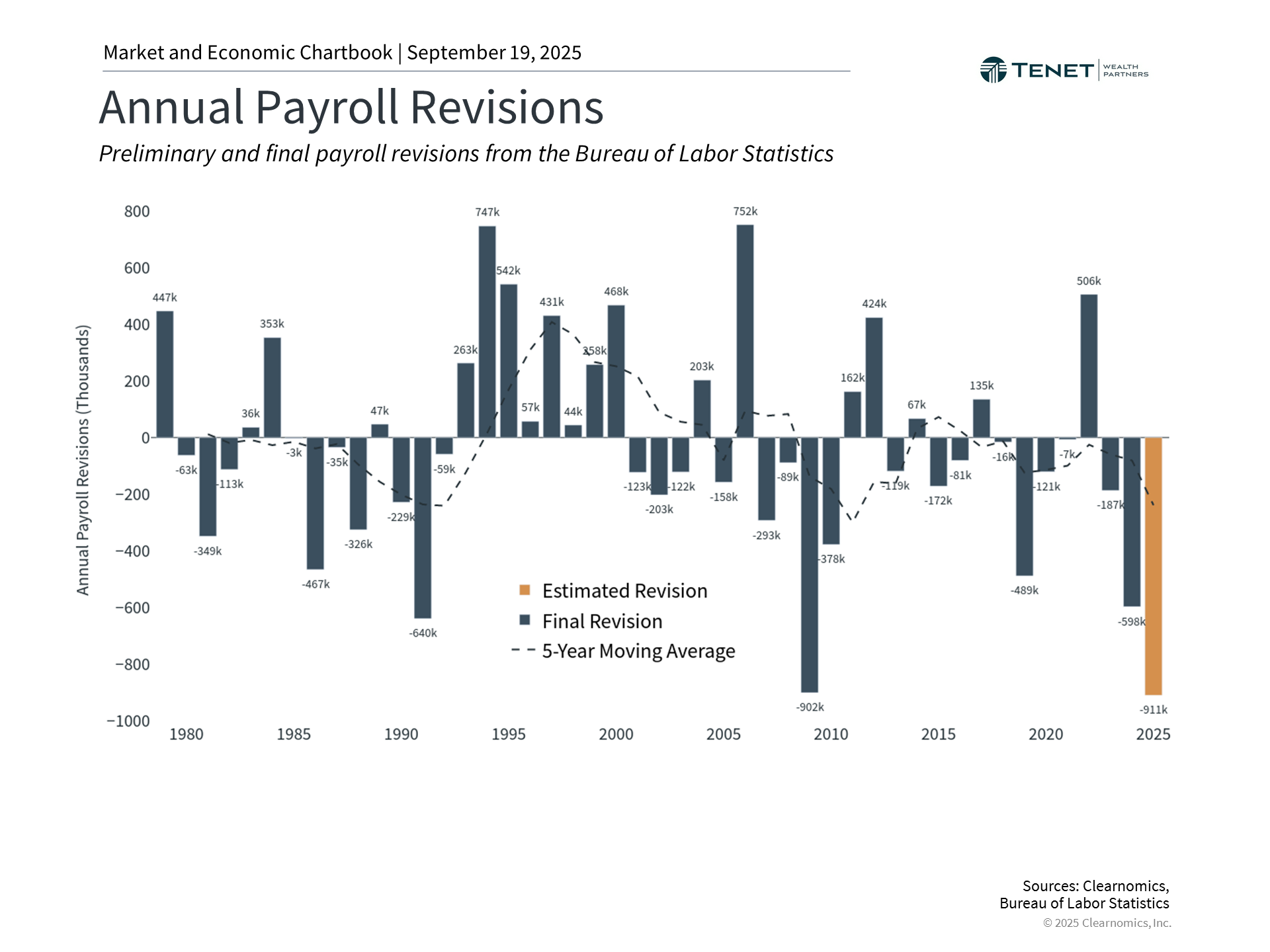The investment adage “don’t fight the Fed” emerged in the 1970s and remains increasingly relevant today. This concept emphasizes that Federal Reserve monetary policy decisions can significantly influence markets and economic conditions, making them crucial considerations for investors. However, maintaining perspective on the broader interest rate trajectory, rather than fixating on individual policy moves, remains essential. This context proves particularly important as the Fed advances its rate-cutting cycle within today’s complex economic landscape.
As markets anticipated, the Federal Reserve reduced policy rates by 0.25% during its September meeting, extending the easing cycle that commenced in 2024. This action occurred while markets trade near record levels, economic indicators present mixed signals, and uncertainty persists regarding tariffs and inflation pressures. Unlike emergency rate reductions during the 2008 financial crisis or 2020 pandemic, this current move represents the Fed’s effort to calibrate policy for sustained growth rather than crisis response.
For investors with long-term horizons, comprehending the Fed’s rationale for rate cuts and recognizing how this environment differs from previous cycles offers valuable insight for financial planning and portfolio management. Although rate reductions typically support financial markets, the critical factor involves maintaining perspective and concentrating on long-term financial objectives rather than overreacting to each policy adjustment.
The Fed’s rationale for rate cuts carries more weight than timing or magnitude
 |
Federal Reserve officials analyze economic data encompassing growth, employment, and inflation when formulating policy decisions. When economic outlook remains unclear, it’s common for Fed officials and economists to hold divergent views, creating disagreement about future rate cut timing and scale. This situation characterizes today’s environment, with substantial variation among officials’ rate projections. While many headlines emphasize political tensions between the Fed and White House, the reality shows this divergence has existed throughout the process.
Despite these disagreements, several key facts merit consideration. Initially, the Fed had long anticipated implementing rate cuts. Recent Summary of Economic Projections publications indicated rate cuts would likely begin this year, even though the quantity and size have fluctuated based on tariff developments and market volatility. The Fed’s most recent projections suggest two additional cuts could occur this year, accompanied by an enhanced growth forecast.
Additionally, this latest rate cut differs fundamentally from historical cutting cycles primarily driven by emergencies. Current rate reductions continue reversing the sharp rate increases implemented to combat inflation beginning in 2022. These cuts also occur against a softening yet positive economic environment, despite potentially weakening employment data and more persistent inflation than anticipated. In essence, the Fed’s quarter-point rate reduction to guide economic conditions differs significantly from substantial emergency cuts responding to financial system problems or economic crises.
Furthermore, Fed Chair Jerome Powell’s term will likely conclude in May 2026. President Trump will appoint the next Fed governor, suggesting the federal funds rate will probably trend lower. While this could mean short-term interest rates will likely decline, it’s crucial to remember that market and economic forces, not Fed policy, drive long-term interest rates. For instance, if lower short-term rates stimulated higher inflation, this might inadvertently produce higher long-term rates.
Therefore, while this rate cut represents the Fed’s continuation of its 2024 trajectory rather than a complete directional shift, it also demonstrates the Fed’s dedication to supporting economic expansion.
Economic indicators have shown mixed performance recently
 |
Labor market softening served as a primary factor in the Fed’s decision. The economy generated only 22,000 jobs in August, significantly below expectations, with previous months’ figures revised downward substantially. However, the unemployment rate increased only to 4.3% due to fewer individuals seeking employment. Again, this differs from past emergency rate cut periods. During the 2008 financial crisis, unemployment surged from 5.0% to 10.0%, and in 2020, it jumped from 3.5% to 14.8%. Today’s employment figures suggest more gradual cooling that may indicate softening labor market conditions.
Contributing to labor market weakening concerns, recent payroll revisions have illustrated a more subdued job growth picture than previous data suggested. The Bureau of Labor Statistics’ annual revision process revealed 911,000 fewer new jobs were created from March 2024 to March 2025, indicating the labor market was cooling more rapidly than policymakers recognized when making earlier monetary policy decisions. These preliminary estimates will be finalized in early 2026.
While weakening labor market conditions would support interest rate reductions, the Fed’s inflation concerns favor maintaining steady rates, or potentially raising them if tariffs drive prices higher. The Fed’s preferred inflation measure, the Personal Consumption Expenditures (PCE) Price Index, at 2.6%, remains significantly above the 2% target. Core PCE hovers at 2.9%, while headline and core CPI have remained persistent at 2.9% and 3.1%, respectively. Earlier inflation progress has not only stalled but some trends have reversed in recent months.
The Fed must balance these factors as part of its “dual mandate.” The conflicting signals from these indicators explain disagreement both within the Fed and with the White House. For investors, understanding these trends will likely prove more valuable for comprehending the economic and interest rate environment than monitoring daily political headlines.
Rate reductions typically benefit businesses and investors
For investors, the crucial distinction involves whether rate cuts accompany recession or support continued expansion. While some economic weakness indicators exist, recession signs have not yet emerged. In these circumstances, rate cuts typically provide broad benefits across financial markets. Reduced borrowing costs make it less expensive for companies to finance growth and decrease debt service expenses. Consumer spending may increase if mortgage and credit card rates decline, enhancing demand for goods and services.
One concern regarding today’s rate cuts involves the stock market already trading near record highs. While this scenario is uncommon, historical precedent exists. For example, under Alan Greenspan, the Fed implemented three rate cuts in 1995 and 1996, describing the cuts as “insurance” against economic slowdown. The Fed also made cuts in 2019 at market peaks to address global growth concerns. At the recent press conference, Powell characterized this latest policy decision as “a risk management cut” due to the Fed’s assessment that “downside risks to employment have risen.”
For portfolios, history demonstrates that rate cut effects are generally positive across asset classes. While past performance cannot guarantee future results, stocks typically benefit as lower rates reduce the discount rate for future earnings and improve corporate profitability, particularly among growth-focused businesses. Meanwhile, bonds typically gain value due to their higher rates, although this can vary across bond sectors and maturities. Conversely, cash will likely experience lower yields, making it even less attractive compared to investments like stocks and bonds.
While each economic cycle presents unique characteristics, navigating policy changes represents a normal aspect of investing. Importantly, rate cuts generally support long-term investors, although balancing risk and reward requires comprehensive understanding of market trends.
The bottom line? The Fed’s recent rate cut may support economic conditions amid mixed signals. Investors should maintain long-term perspective, emphasizing overall market direction rather than individual Fed decisions.

Registered Representative of Sanctuary Securities Inc. and Investment Advisor Representative of Sanctuary Advisors, LLC. Securities offered through Sanctuary Securities, Inc., Member FINRA, SIPC. Advisory services offered through Sanctuary Advisors, LLC., a SEC Registered Investment Advisor. Tenet Wealth Partners is a DBA of Sanctuary Securities, Inc. and Sanctuary Advisors, LLC.
The information provided in this communication was sourced by Tenet Wealth Partners through public information and public channels and is in no way proprietary to Tenet Wealth Partners, nor is the information provided Tenet Wealth Partner’s position, recommendation or investment advice.
This material is provided for informational/educational purposes only. This material is not intended to constitute legal, tax, investment or financial advice. Investments are subject to risk, including but not limited to market and interest rate fluctuations.
Any performance data represents past performance which is no guarantee of future results. Prices/yields/figures mentioned herein are as of the date noted unless indicated otherwise. All figures subject to market fluctuation and change. Additional information available upon request.

